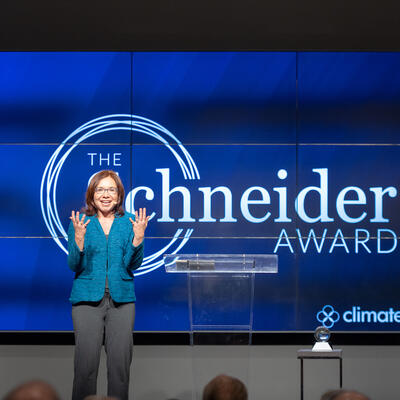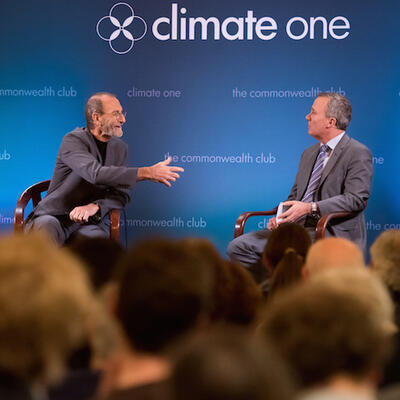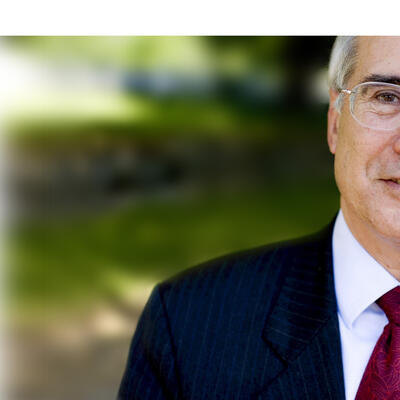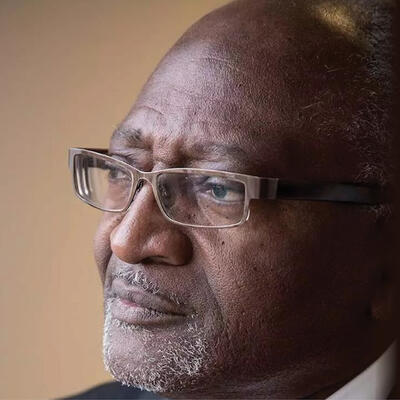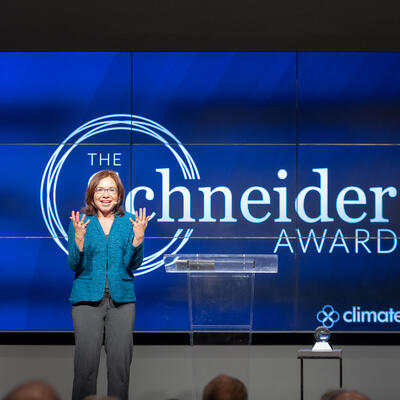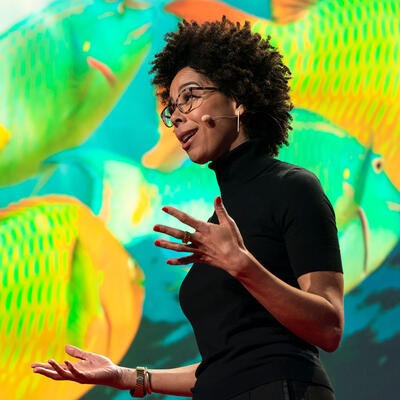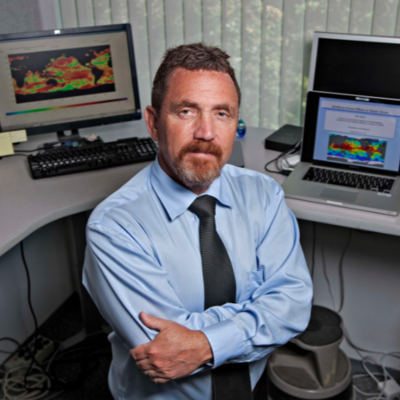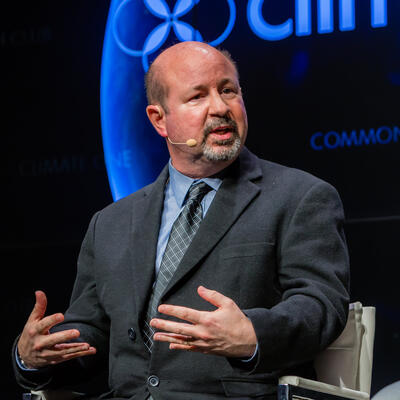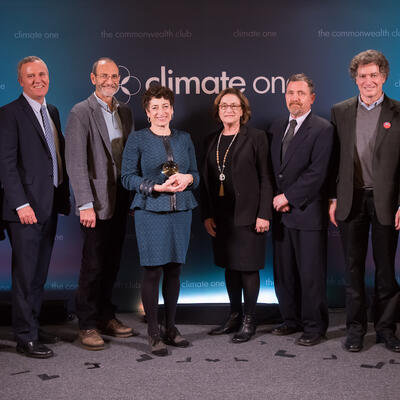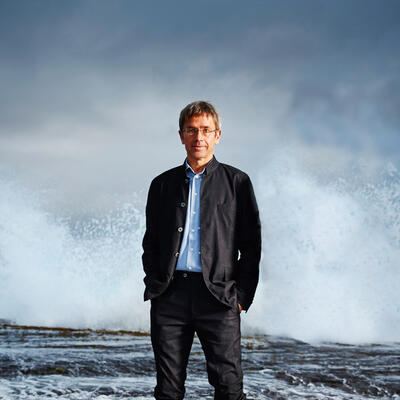
Stefan Rahmstorf: 2022 Schneider Award Winner
Guests
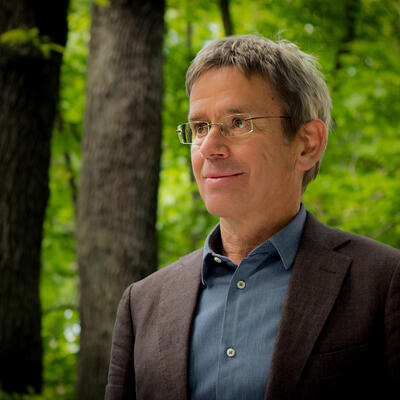
Stefan Rahmstorf
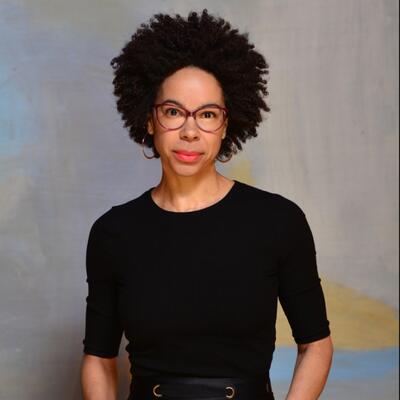
Ayana Elizabeth Johnson
Summary
Every year, we grant an award in memory of pioneering climate scientist Steve Schneider, a who fiercely took on the denial machine from the 1970s until his death in 2010. This year's recipient is German physicist and ocean expert Dr. Stefan Rahmstorf. Dr. Rahmstorf says we’re running toward a cliff in a fog. What can science tell us where that cliff is – and how to avoid it?
In a time of oceanic changes happening at an unprecedented pace, Dr. Rahmstorf exemplifies the rare combination of superb scientist and powerful communicator. He works to convey the impact of climate disruption on ocean currents, sea level rise, and increasing extreme weather events fueled by warmer oceans.
We are already experiencing the devastating effects of a warming planet, and we are inching closer to several tipping points that could change life as we know it. According to Rahmstorf, we are in the middle of a global die off of coral reefs: “We are basically in that tipping point process now. And the latest IPCC report said after 2° warming basically no coral reef will be left.” He also says that we may be past the tipping point for the West Antarctic ice sheet, “The tipping point is where the further deterioration and actually complete loss of the ice sheet is already programmed in by self-amplifying feedback even without further warming.”
On the other hand, Rahmstorf says, further warming itself is not inevitable. “The science suggests that once we have reached zero CO2 emissions, the temperature will not rise further.” But he also recognizes that getting to net zero emissions won’t be easy, “With the politics we have now it is not possible of course, we have to be treating this problem as a top priority like a wartime situation.”
Earlier in his career, Dr. Rahmstorf was attacked for calling out climate skeptics in mainstream journalism. He remarks, “That put a big stress on me. Obviously if you are attacked and discredited in mainstream media simply for telling the truth and calling out disinformation on climate change.” Despite that experience, he believes that the debate around climate has changed significantly. At one time, outright denialism was the barrier scientists were up against, but now he says, “There is no outright or very little outright denial of the basic scientific facts. The whole discussion has shifted to criticizing the solutions.” But he also feels that, while scientists have a duty to tell the public what they are working on and what they’ve discovered, change won’t happen with scientists alone. They need the public to pressure governments to act:“This is the kind of pressure that is needed because scientists explaining in sober terms in IPCC reports what is at stake – we've been doing this since 1990, and it's just not happening.”
Even though communities of color experience the worst effects of the climate crisis, white voices are often centered in the public sphere. Dr. Ayana Elizabeth Johnson, marine biologist and winner of last year’s Schneider Award, wants more inclusion in climate spaces, “We need leaders who can lead their communities and that means we need a broad diversity of leaders. We need a lot of ideas at the table.” She continues, “A lot of the work that I do in terms of climate communication really aims to say like you are welcome in this work, you are needed in this work, let's think about where you will fit in.”
Resources From This Episode (3)
Full Transcript
Note: Transcripts are generated using a combination of automated software and human transcribers, and may contain errors. Please check the actual audio before quoting it.
Greg Dalton: I’m Greg Dalton and this is Climate One.
Every year we grant an award in memory of the late Steve Schneider, a pioneering climate scientist who fiercely took on the denial machine from the 1970s until his death in 2010. He launched his last book, “Science As a Contact Sport,” on the Climate One stage and was a guide to me when I first entered this field.
This year's recipient is German physicist and ocean expert Dr. Stefan Rahmstorf.
In a time of oceanic changes happening at an unprecedented pace, Dr. Rahmstorf exemplifies the rare combination of superb scientist and powerful communicator. He works to convey the impact of climate disruption on ocean currents, sea level rise, and increasing extreme weather events fueled by warmer oceans.
Earlier in his career, Rahmstorf was attacked for calling out climate skeptics in mainstream journalism.
Stefan Rahmstorf: That put a big stress on me. Obviously if you are attacked and discredited in mainstream media simply for telling the truth and calling out disinformation on climate change.
Greg Dalton: And how has the conversation evolved or changed since then? Is it better or worse now?
Stefan Rahmstorf: Well, it’s actually I think it's a lot better now because the debate about climate change has moved on a lot. And at least, you know, I can only speak for Germany here. There is no outright or very little outright denial of the basic scientific facts. The whole discussion has shifted to criticizing you know the solutions, renewable energy, electro-mobility, etc. So, the debate also in this field contains a lot of false information put out by interest groups, but it doesn't concern the basic research as climate science researchers like myself so much anymore.
Greg Dalton: Right. It seems like a lot of the skepticism about climate stems from the fact that climate models were predicting effects that most people weren't yet experiencing in their lives. You know, this kind of far away in time and faraway lands. What do you think people distrust models and how both as a scientist and science communicator do you explain why we should believe in the predictive models?
Stefan Rahmstorf: Well, in a way I can understand that people distrust models as such, because they don't know what's in there. They don't really understand in detail what we are doing. But I think one of the big effects beyond the healthy distrust of models is that as scientists we also have of course we are very critical of each other's models and hopefully our own as well. And you really have to learn what a model can do well and what it cannot do well. But I think a big issue with the distrust of the general public of models in climate science overall is that this has been deliberately stoked by interest groups. In a way, it's not surprising that there is a lot of distrust there.
Greg Dalton: And have the models been conservative have the models actually underestimated the pace and magnitude of changes that we’ve seen in the atmosphere?
Stefan Rahmstorf: That again depends on what you are looking at. If you are looking at the change in global average temperature, that has been spot on in the model since the 1970s and 80s already those early models got that pretty well, right. Not only the models by university scientists or NASA, but also by Exxon, for example, did their own modeling and they also get it pretty well, right. There are other things that are more complicated physics like rainfall extremes for example, is more difficult and there is still a lot of uncertainty in regional terms where you expect what kind of extreme precipitation changes. And in one of my main fields of research for quite a few years has been sea level rise. That has also turned out to be quite a complex problem because there are several contributors, especially the ice sheets are very difficult to predict in their behavior. The sliding behavior depends on the material properties of the ice. And there we unfortunately have a history of underestimating sea level rise. And the IPCC had to raise its sea level projections several times basically every time in the last three times a new report came out the sea level projections have become more pessimistic as we learn more about potential ice sheet instabilities.
Greg Dalton: So, what I heard there is that, yeah, models are like a black box to most people, even me I never actually seen a climate model. I’ve talked to lots of people who make them and talked about them, but I've never actually seen a climate model. So, they are a black box and on surface temperature they’ve been very accurate. And on sea level rise they’ve actually underestimated something that is very complex. You said that we’re running toward a cliff in a fog and we don't know exactly where the cliff is. How far can models go toward letting us see through that fog?
Stefan Rahmstorf: Well, this quote was about tipping points where we indeed we know there are these tipping points. But we typically have a fairly large uncertainty range about exactly where this tipping point is going to be by at how much warming are we going to cross that tipping point. And this is a classic case because tipping points by definition are highly nonlinear phenomena. So, complicated physics and these nonlinear phenomena they depend exactly on the boundary conditions, and in many cases, we just can't pin that down very easily. Whereas other things like I mentioned the global mean temperature just follows a global energy balance. We know how much radiation is coming in, ow much longwave radiation is going out and how that's going to change when we increase in greenhouse gases because it's a fairly smooth change in the global energy budget. And so, that's pretty easy to predict. But those cliffs like the tipping points, are often well understood in principle but not where exactly that cliff is.
Greg Dalton: Let's talk a little more about tipping points. In one of your talks I've seen you show a graphic of various tipping points and at what temperatures they would be triggered. Can you talk through us some of the most imminent dangers because there are kind of three bands of tipping points? Those that could happen relatively soon. Those that are sort of medium-term and those that are further out. What are the ones that are closest the ones a little further out?
Stefan Rahmstorf: Yeah, this graph comes from a review paper in Science that was published this September by David Armstrong McKay and colleagues from several countries. And in a way it did really shock me to some extent because they are now indeed, when you put together the latest science six tipping points that even not just possible but even likely to be crossed within that range between 1.5 and 2.0° of global warming.
Greg Dalton: We’re at about 1.1 now so that’s not very far away, right?
Stefan Rahmstorf: Exactly. the coral reefs, for example. A long time it has been known that they have critical temperature thresholds and we are now already since 2015 in the middle of a global coral die off. So, we are basically in that tipping point process now. And the latest IPCC report said after 2° warming basically no coral reef will be left. Another one is the West Antarctic ice sheet which may already have passed the tipping point. I should add that the tipping point is where the further deterioration and actually complete loss of the ice sheet is already programmed in by self-amplifying feedback even without further warming. So, that's what the tipping point is and it means you can't necessarily see it when it's happening with these ice sheets because they are moving very slowly and there is no dramatic change once you've passed the tipping point. But what it means is it's going to continue to decay until it's gone. In case of West Antarctic that would be 3 meters global sea level rise. Greenland ice sheet it’s a different mechanism but the same thing. We may already be passing the tipping point very soon. We might even already have passed it, and that would just mean the total loss of the Greenland ice sheet would be programmed in to occur over the next centuries and unstoppable basically, and that would mean 7 meters global sea level rise.
Greg Dalton: Let me just jump in here, Stefan. These are places most Europeans Americans will never go to or see, the West Antarctic ice sheet or the Greenland ice sheet. What does it mean for someone living in Europe, North America anywhere? Why should a person care about these faraway things?
Stefan Rahmstorf: Well, in case of the ice sheets the main reason to care about them is the sea level rise they are causing, and we are expecting, the IPCC is expecting half a meter to 1 meter sea level rise by the end of the century. But with a big one-sided uncertainty to much higher values like 2 meters by the end of the century, 5 meters by the year 2150 as a result of potentially passing these tipping points where amplifying feedbacks really destabilize these ice sheets. And that means basically the loss of most of the world's coastal cities and also natural ecosystems along the coast beaches being washed away by the rising seas, etc.,
Greg Dalton: And these things are closer and more likely than you estimated a couple of decades ago, is that correct?
Stefan Rahmstorf: Absolutely. Even closer than I thought five years ago.
Greg Dalton: Wow. And then there's some that are further out that are you know, sort of happen between 2 and 4° that is, you know, the Sahel. Tell us about the range the Amazon and the Sahel the things that happened between 2 and 4° of warming which we hope we won't get to and we’re currently on a trajectory if everybody meets their Paris climate agreements we won't get to that point, but it could happen.
Stefan Rahmstorf: It could happen and for the Amazon rainforest there is a tipping point where it simply gets too dry to be maintained. And that has to do with the fact that the rainforest generates its own rain and recycles the water that falls in one area. The roots pick it up from the ground again, push it up to the leaves and they evaporated again. And so, that rainfall is recycled again and again by the forest and that is a self-sustaining feedback which is typical for a tipping point, because when you stress that too much, it turns into the opposite. The forest dies back and that recycles less rain that amplifies that die back and then the Amazon rainforest basically threatens to get so dry that big parts go up in flames. Now with the Sahel and West African monsoon this is actually in a way a positive tipping point I would say. And because we’re talking about the potential greening there like we had in the first half of the Holocene where we had a stronger West African monsoon bringing in moisture from the tropical Atlantic. And so, this could actually lead to a greening of the southern fringes of the Sahara. And so, not all tipping points are negative and we are all hoping for a societal tipping point where the world society finally takes climate change seriously enough to stop it.
Greg Dalton: So, there will be some, you know that’s a rare example of actually something a positive trend anywhere and particularly for Africa. So, are you saying there’ll be winners and losers in this?
Stefan Rahmstorf: Well, of course that tipping point for the greening Sahara will only be reached if we have pushed warming already far too far or way beyond 2° and we are in the middle of fighting disaster. So, that is little consolation that further out there may be even some positive change.
Greg Dalton: You’re listening to a Climate One conversation with this year's winner of the Schneider Award for climate science communication. We value you as a listener, and your rating or review of our show helps others find our podcast and learn more about the climate emergency. Please take a moment to rate or review us on your pod app. Coming up, why 1.5° of warming may not be inevitable.
Stefan Rahmstorf: A lot of people think we are already inevitably going to surpass the 1.5°. That is not what the science is saying. The science suggests that once we have reached zero CO2 emissions, the temperature will not rise further. (:16)
Greg Dalton: That’s up next, when Climate One continues.
Stefan Rahmstorf: The first thing I remember about Steve is his 1989 book called “Global Warming: Are We Entering the Greenhouse Century?”, which I read as a PhD student in the late 80s when the book came out. And that was to me one of the eye openers at the time about that greenhouse problem. And indeed, I had a fair amount of interactions with Steve over the years and I would call him a friend. And one of the things I talked quite a bit to him about and where he was very vocal in public as well was the thing about thinking about risk about probabilities and to also take seriously low probability events. This is something I really learned from Steve because the IPCC until quite recently has been focusing strongly on the best estimate scenarios of you know what is most likely to happen, but not focusing on the tail end of the probability distribution and what risks are lurking there. It’s a bit like analyzing the risk of running a nuclear power plant and you just look at scenarios where everything runs according to plan but of course to understand risk you have to also look at the things that may go wrong even if it's not very likely. And so, Steve and I we were both quite vocal about this issue to consider the risks as well, and I remember in 2000 he invited me to write an editorial for his journal the first climate change journal which was called climate change on the thresholds of what we now call tipping points of the Atlantic journal overturning circulation. And the other where Steve was really a mentor to me was public climate science communication. He was really somebody who he encourages everybody basically to get involved in the public debate. It's not enough to just put your stuff in the peer-reviewed technical literature. He was convinced you have to put it out into the public arena and debate it.
Greg Dalton: And so, what do you consider the role of a scientist because there’s some data about whether scientists ought to stick to their stay in their lane, stick to their laboratory what they know not veer into policy, not get into politics. Others say there's a moral responsibility. What do you view as the role of a scientist at this time focusing on this?
Stefan Rahmstorf: Well, I think we definitely have a duty to explain what we’re doing and what we are finding out to the general public. Like doctors have a duty to warn their patients that smoking causes lung cancer and, you know, if you know about the risks that affects people you have to speak up. I don't think that necessarily it's a role of a physicist to tell the government what it should be doing. And we generally I think a scientist don’t the IPCC doesn't, it's, you know, when the politicians want to know how do we stop global warming for example, at 2° also then as natural scientists we can say how much what's the emission's budget, you know, how much can we still emit in terms of CO2 if we want to stick to that goal. And so, I think we need to communicate the risks, but not necessarily solutions. But there are other scientists like renewable energy experts, economists, etc. that are really engaged in designing policy measures for example, a carbon pricing scheme that is fair so that low income households actually have more money in the bank afterwards and so the burden for changing the energy system and reducing CO2 emissions should really be paid by the high emitters which are typically the people with more income.
Greg Dalton: Yeah, the Global North. We’ve done a number of episodes on that on Climate One recently from COP 27. Much of your work has been in the field of paleoclimatology. How has studying ice ages informed your understanding of current and future climate change and how do you communicate with people who average person has a hard time really grasping geological timescale.
Stefan Rahmstorf: Yes, quite early already when I started as a postdoc turned to studying paleoclimate because you know I was studying abrupt ocean circulation changes. And, you know, we can’t observe that in the last hundred years, but we can if we go back further in time because they have happened repeatedly during the last ice age. So, if we want to test our models can they reproduce these phenomena realistically, we have to compare them to paleoclimatic so-called proxy data that come from the ice cores or sediment course from the deep ocean, etc. And most people that I talked to or give lectures, public lectures they are amazed how much we actually know about past climate changes, and about the mechanisms, especially when you look at the past few million years which of course is a short part of the total earth history of 4 1/2 billion years. But the last few million years we have very nice data from sediment cores all over the planet. We know the waxing and waning of the big continental ice sheets and with our climate model for example, we can now reproduce all the ice ages of the last 3 million years just driven by the cycles in the earth orbit, the so-called Milankovitch cycles which are the course of these cyclical ice ages. And so, I think the main thing it teaches us is that the earth system the climate system is a sensitive beast that responds strongly when you change the forcing for example, either by these orbital cycles or by adding carbon dioxide to the atmosphere. This is what we call the forcing radiative forcing and we know from the earth history that the earth responds very strongly to this. So, that's the so-called climate sensitivity. How sensitive is our climate system? And my colleague Wally Broecker, who unfortunately also already died like Steve Schneider, he used to say the climate is an angry beast and we are poking it with sticks.
Greg Dalton: It’s an angry beast and a sensitive beast. That’s quite a powerful image. You mentioned the Greenland ice sheet and the Antarctic ice sheet and how there's some melting there that's faster. It's complicated, but faster than you would've predicted just a few years ago. We have enough ice left on earth to raise sea level by 60 meters, that's almost 200 feet. This is a mind-blowing number obviously, you know, your paly of work you know it's been that high before but not on an earth with 8 billion people. So, how do you imagine a 60-meter sea level rise and still function? I mean that’s just a mind-blowing number.
Stefan Rahmstorf: Yeah, that is a really big number and we know that at the end of the last ice age, you know, which is only 10,000 years ago, so that, and I mean the height of the ice age was 20,000 years ago and then between 20,000 and 10,000 the ice age came to an end. We moved into the Holocene warm period, the interglacial. And there the sea level rose by 120 meters because two thirds of those ice age ice masses on the continents were melting in response to about 7° of warming from the ice age to the Holocene. 7°C global warming caused 120 meters of sea level rise. So, the fact that we still have 65 meters worth of sea level rise lying in form of ice on the continents, to me, it doesn't mean that sea level will ever rise by 65 meters because well, certainly not in the next 1000 years because Antarctica is simply right on the south pole and very cold and the main part Eastern Arctic is not gonna melt down. But what it means is that we can afford to lose only a few percent of that continental ice. And, you know, last time we had several degrees of warming, you know, two thirds of the ice melted 120 meters of sea level rise and now we're heading for 3, 4° warming maybe half as much. And we can't even afford to lose this kind of a few percent of the ice. Even one meter of sea level rise would for many places be really catastrophic. We’re already witnessing real problems after the 20 cm of rise that we have seen since the late 19th century. We have already at the US East Coast for example, the so-called nuisance flooding in quite a few places. The Carolinas, Boston, for example, where even with the tidal cycles you get some low-lying streets underwater.
Greg Dalton: So, some people say that even if we stop emissions there’s momentum in the system: warming will continue, seas will continue to rise. how much sea level rise is already baked in?
Stefan Rahmstorf: Well, let's first say how much further warming is baked in because a lot of people think we are already inevitably going to surpass the 1.5°. That is not what the science is saying. The science suggests that once we have reached zero CO2 emissions the temperature will not rise further.
Greg Dalton: Great. Let’s just hold on to that for a moment. They say the science so sometimes the public discourse gets darker than the science. And we get these moments of light. I like to pause and hold on to them. That once we stop emitting the warming will stop. That's really good news.
Stefan Rahmstorf: Absolutely. Yeah, that’s the good part of us causing it. It means we can stop it. And in the global temperature there's not much inertia.So, that is really what we have to aim for: get to zero emissions before or at the time where we reach 1.5°. And that is theoretically possible. With the politics we have now it is not possible of course, we have to be treating this problem as a top priority like a wartime situation basically, in order to get such a really fast end of fossil fuel use. Now, there is, of course, a lot of inertia in the sea level issue because the ice sheets are very slow to melt. That's the main reason but also heat penetrating into the oceans is also a gradual, slow process. So, after we stabilize the global temperature, sea level will continue to rise for many centuries. And the best we can hope to achieve by stopping global warming is to prevent further acceleration of sea level rise.
Greg Dalton: So, I heard a lot of positive news there. We hear a lot about net zero goals these days. When we get to zero emissions, some of the bad things will stop pretty quickly. Some will continue slowly rising seas with the thermal acceleration. So, that really gives me encouragement that this net zero goals we’re talking about that are we’ll see pretty immediate effects when we get there. It won't be some long delay. That we’ll see some pretty quick results that it’s a goal worth fighting for and getting toward.
Stefan Rahmstorf: Absolutely. I mean, just think about it overland when the sun comes up in the morning, you know, it gets hot within hours. So, that's how fast the atmosphere responds to a change in radiative forcing. The inertia is in the oceans and so maybe in coastal regions, things will not be noticeable so quickly, but a lot of the CO2 effect is very immediate and with every molecule of CO2 that we add we change the radiation balance. And once we stop doing this, we will stop making things worse.
Greg Dalton: One way to avoid tipping points could be dimming the sun to cool the earth possibly known as solar and geo-engineering. What do you think of geo-engineering? Is climate inaction making solar geo-engineering more likely, perhaps even inevitable?
Stefan Rahmstorf: I think it's a terrible idea because of huge side effects and also to a large extent unknown side effects that this would have. And you have to consider that this CO2 that we add will remain in the atmosphere at an elevated level for literally tens of thousands of years. So, we actually in my department have a couple of projects from the Swiss and the German authorities about nuclear waste storage because these people are interested what happens in the next million years. And so, because we can successfully model the ice ages of the last 3 million years and these Milankovitch cycles of the earth orbit can be calculated with astronomical precision also into the future. We can also predict the next ice ages. The next one would be happening in 50,000 years from now. But we can say that is practically already canceled because even in 50,000 years CO2 will be still so elevated in the atmosphere that the new ice age, the next ice age will not be happening. So, this is very long-term and the counter effect by adding these particles shading the sun and the atmosphere, which some people discuss, etc., they will wash out within weeks basically, if you don't keep renewing them all the time. And so, once we do this, we add a lot of CO2 but at the same time we add kind of short-term shading aerosols in the stratosphere also. We will have to keep doing this for tens of thousands of years to keep a habitable planet. And at that point we would hand over the control over the climate system to humans rather than leaving it as a self-regulating system. And I think this is a terrible idea.
Greg Dalton: There's a saying that what happens in the Arctic doesn't stay in the Arctic. The jet stream is slowing, according to different studies using different methods. How does the melting Arctic ice affect the jet stream and how could that affect Europe? I talked to people who are very worried in Europe about the jet stream changing.
Stefan Rahmstorf: The changes in the jet stream data show that in some of the jet stream slowing down. Also, further analysis shows that it's getting more wavy in the winter. You get these instabilities in the polar vortex letting out cold air outbreaks from the Arctic to adjacent continents. And these things have to do with the disproportionate warming of the Arctic, which has actually warmed 3 to 4 times faster than the global average temperature in the last decades. And that basically reduces the temperature gradient that drives the jet stream, you know, the difference between the subtropical atmosphere and the polar atmosphere. The temperature difference is getting smaller because the North Pole is warming up such a lot. And we think that this leads to more persistent weather, especially in Europe, so same weather situation, lasting longer and thereby becoming extreme. You know if you have one week with no rain it’s not a problem but you know if you have three weeks with no rain you have a problem. Or when you have a low-pressure system dumping a lot of rain you also have a problem when it stays for a week over the same place because it's going to cause massive flooding like we had last year in Germany, Belgium and the Netherlands.
Greg Dalton: Angela Merkel was a huge figure on the world stage for a long time. She was a physicist. She knows the science; what has been her climate legacy?
Stefan Rahmstorf: Well, unfortunately, I would say she was very good at using nice words and especially on the international arena. And quite, you know, riveting speeches about global warming and she's been I've seen her several times in person speaking to audiences of scientists at the meetings that we organize, etc., And she always said the right things and then you know she intervened in Brussels against emission standards for motorcars, etc. And also, you know I think her government basically stopped our photovoltaics industry and our wind industry. They strongly halted the exponential growth of wind power in Germany because there was a lot of fossil fuel interests there and our strong dependence on Russian fossil gas now that we are now suffering with the Ukraine war from. This dependence also that was all growing during her government. So, I think climate people here in Germany are especially disappointed with her because she did understand the problem and she said the right thing but she didn't act accordingly.
Greg Dalton: What energy trajectory is Germany on now? I know that they just signed a long-term liquid natural gas contract with Qatar that goes out into several more than a decade from now.
Stefan Rahmstorf: Well, this is actually quite difficult to say because on one hand we now have a climate ministry run by a green minister, Robert Habeck, who are working hard to remove obstacles to the renewable energies and build them up faster. And we are now in Germany at around about 50% of our electricity is coming from renewables and the plan is to be at 80% in 2030. That's the good news and the actually there are new reports by the International Energy Agency on renewables has really upped the estimates dramatically how quickly the renewables worldwide will increase, and including because they now say now after the attack on Ukraine there will be an acceleration also in Germany with the buildup of renewable electricity generation. That's the one side. But you mentioned those LNG terminals. There is a big debate about those because it’s kind of a fossil lock-in effect and people try to say how well they can later be used for hydrogen, green importing green hydrogen. But I'm certainly not an expert on this, I'm outside my core expertise here, but I see reports from experts saying this is just kind of greenwashing. These terminals are not suited for hydrogen. And so, this is not gonna happen. And yeah, environmental organization here is going to court against these LNG terminals because they are basically contravening Germans climate policy just like the British new coal mine that is going to be opened. That really undermines the credibility of Great Britain in climate policy. I just see the fossil fuel lobby kind of you know it's like whack-a-mole they’re popping up everywhere. You try to make this transition away from fossil fuels, but the power of the forces that want to hold onto fossil fuel burning is still very strong. And, you know, they're making record profits at the moment and they’re using that money also for lobbying power.
Greg Dalton: So, how do you think that, I understand this is not a physicist question. But how do you think that power is challenged or changed?
Stefan Rahmstorf: Well, I think by the public, basically, demanding climate action and I think a big impact was by the Fridays For Future movement and the general climate movement that has really grown in recent years the last five years or so, it has become quite powerful and I can see that you know fossil fuel dependent governments, like in Australia get voted out and also in Germany of course I mean we could have had Angela Merkel’s party again in government. I think had not been for this the climate issue and the massive flooding we had last summer in West Germany, the climate topic is now something that voters demand and that people, the young people, especially demand in the streets. And I think this is the kind of pressure that is needed because scientists explaining in sober terms in IPCC reports what is at stake. We've been doing this since 1990 when the first IPCC report came out and it's just not happening. So, I think it needs more political pressure.
Greg Dalton: We've had an attack on science and a lot of reason-based thinking in the United States seems to have subsided a little bit. What advice do you have to people who want to pursue science and are maybe turned off by the nasty politics surrounding science these days?
Stefan Rahmstorf: I would say do it anyway. And I think go into the solutions field, you know, study energy systems, etc. Because basically we understand the climate system well enough to know what we should be doing and we really need people working on the solutions.
Greg Dalton: This is Climate One. I’m Greg Dalton.
Last year’s recipient of our climate science communication award was marine biologist, policy expert and writer Dr. Ayana Elizabeth Johnson. She’s co-founder of the Urban Ocean Lab and co-creator of the The All We Can Save Project.
After an op-ed piece where Johnson proposed a Blue New Deal, the Elizabeth Warren presidential campaign took notice and asked her to formalize the plan. In our conversation last year, I asked her about that experience.
Ayana Elizabeth Johnson: This is actually the piece of climate communication that I think I'm most proud of and it’s the one I speak the least about now. And it just the idea came to be just over a lunch with Chad Nelsen who’s is the CEO of Surfrider. We were both talking about having read the Green New Deal resolution and you get to page 10 or 11 out of 14. For those who haven't read it it is short it is double spaced and large font it’ll take you like five or 10 minutes. And I thought wow this is really ambitious and exciting, but they left out the ocean and so it will not work. Because the ocean has absorbed 90+ percent of the heat we've trapped with greenhouse gasses, right. It's absorbed over about a third of the carbon dioxide we’ve emitted. It is buffering us from the impacts, it is providing all the solutions in terms of protecting shorelines and renewable energy. And so, we leave out the ocean then we’re leaving out what a report that came out earlier this year calculated about 20% of the climate solutions available to us. And so, Chad Nelsen and I thought well how can we help to make sure the ocean is included and then we ended up connecting with Bren Smith who is a regenerative ocean farmer who cofounded a nonprofit called GreenWave, who was also working on the same concept and the three of us put our heads together for that op-ed in grist, called the Big Blue Gap in the Green New Deal. And that sort of became a policy memo with Data for Progress and that caught the eye of the Warren campaign and then with Maggie Thomas who was her climate advisor who is now chief of staff in the White House on climate working with Gina McCarthy. She and I led the effort to craft that policy plan, which is something you know that those ideas keep moving forward. And that's something that I'm working on now through Urban Ocean Lab, which as you mention is the policy think tank that I cofounded. So, I think being able to interject the ocean into the climate narrative is something that I'm always trying to do. That is the core of my scientific training. So, just consistently raising my hand and saying hey, don’t forget about the ocean when we’re talking about climate solutions and climate policy.
Greg Dalton: Did you know science was going to be a contact sport when you started to pursue a PhD in marine biology? Did you anticipate how rough it would be?
Ayana Elizabeth Johnson: No. But I also did not anticipate in any sense the role that I would end up playing. I never aspired to or expected to be any sort of public figure. My first --
Greg Dalton: Lots of scientists don’t. That’s not why people go into science, right.
Ayana Elizabeth Johnson: Exactly.
Greg Dalton: You wanna be in your lab doing your work.
Ayana Elizabeth Johnson: I also never thought I would be in the lab. So, my first job out of college was working in the policy office at the Environmental Protection Agency in DC. My major as an undergrad with environmental science and public policy. So, I always wanted to work at this intersection of science and policy. And so, for me it was just a matter of how can I get this advanced degree in science in order to make sure that that all the best science is used to inform policy making even if I'm not the one doing that science. I will have the training to be able to interpret it and convey the importance of it in the context of how we form policy. And so, I guess the answer is no but because I never thought of myself really as having a career as a research scientist and I never thought of myself as having a public profile in any significant way. I thought I would just like be a policy wonk who had a bunch of science training that made me useful in a different way. Because some of the best advice I ever got was and there are a lot of lawyers doing policy there aren't as many scientists doing policies that I could help build the bridge from the other direction. So, I kind of thought I would stay out of the fray and I think I’m gonna back out of it now as you know I'm not doing as much public speaking right now. I’m sort of going into a bit of hibernation and look forward to coming back with some new things to say.
Greg Dalton: You reference some of that in an article you wrote in 2020 in the Washington Post, which was my first honestly remember hearing of you and reading about you. I was like, whoa, I’m always on the lookout for rising stars and new voices and faces. And in this you said, “I’m a black climate expert. Racism derails our efforts to save the planet.” In it you quote Toni Morrison saying “The very serious function of racism is distraction it keeps you from doing your work. It keeps you explaining over and over again your reason for being." And I get that and so, part of me doesn't want to ask you about this and yet I feel an obligation to do so. And as a white guy with a show, you know, can we spend a little bit of time talking about going that and you talk in that piece about superficial task and the need to do deeper work.
Ayana Elizabeth Johnson: The thing that I wish more people understood at this intersection of race and climate is that people of color already care and get it. In fact, are more concerned about climate than their white counterparts in the US. And for this knowing we have to thank for this knowledge the last year's recipients of this very award Dr. Leiserowitz, and Dr. Maibach whose research whose polling of Americans shows us that it's about 49% of white Americans who are concerned about climate change, 57% of black Americans and about 70% of Latinx Americans. So, when we think about how are we going to address this crisis. It's how do we build the biggest strongest team. And so, how do we then welcome in the people who already get it who already care who are already disproportionately more likely to want to be a part of the solutions to want their elected representatives to be more active on pushing forward climate legislation who are more likely to volunteer who are more likely to call their members of Congress. And to me one of the most important findings of their research and polling is that it's not just because communities of color are more heavily impacted by climate change and extreme weather events that are fueled by climate change. That’s what we think we think it's because they're getting pummeled and they see it more this certainly that they are more concerned. And the answer is actually that especially for Latinx communities in the US it’s because they have a more egalitarian worldview. It’s because they have the sense of needing to be a part of the solution of this responsibility to your community as opposed to a more individualistic worldview which tends to be what more of the white people have in America in terms of this context around climate. And so, I think there's a really important lesson there that it's not just about climate justice in terms of who is the most heavily impacted, which is where we normally focus our efforts on all the injustices associated with climate change and its absolutely critical to address those and make sure those do not become more extreme and in fact are reversed. But it's also really important to think about who do we need at the table if we’re gonna work on solutions effectively. If we need these transformations in every community all over the world who’s gonna be leading those transformations in every sector in every town in every part of our economy in every corporation in every level of government. And so, we need leaders who can lead their communities and that means we need a broad diversity of leaders. We need a lot of ideas at the table. And when I say diversity I don't just mean racial diversity I mean age diversity, I mean gender diversity, I mean geographic diversity. Diversity in areas of expertise diversity in ways that we think and approach problems. And so, a lot of the work that I do in terms of climate communication really aims to say like you are welcome in this work, you are needed in this work, let's think about where you will fit in, people who maybe didn't think there was a place for them before.
Greg Dalton: Yeah, welcoming rather than kind of guilt or other way coming into it. As cofounder of the All We Can Save Project you focus on nurturing a climate community rooted in the work and wisdom of women. We have an episode of the Climate One podcast titled The Feminist Climate Renaissance that features you, your coeditor Katharine Wilkinson and four women featured in that book. For those who haven't heard that show, how is the work and wisdom of women, particularly BIPOC women different from white men so needed and what we need on climate now.
Ayana Elizabeth Johnson: So, Katharine and I were inspired to create this anthology because we were just so frustrated with seeing you know who was controlling the narrative, who had the mics who have the financial resources to do their work. And in the US, it was largely white man controlling what we think of as you know, who we see when we think about climate who are the leaders --
Greg Dalton: Steve Schneiders of the world, right. This award may be perpetuating that.
Ayana Elizabeth Johnson: I actually think I don't think of that as a problem. I mean, I'm so honored to be following in his footsteps and the footsteps of all who have received this award before me. I was like literally jaw-dropped gob smacked to be in his company. So, it's not about pushing aside the leadership of white men. It's about having more leaders, right. What we need is a leaderful movement as black lives matter sort of thinks about it. We need just more leaders as well as different leaders. And the way that Katharine and I sort of framed that in the opening essay of All We Can Save was to identify a few key features of the leadership that we were seeing of women that was different and remarkable and important and worth uplifting. And of course they are characteristics that anyone can embody and so it's this clear focus on making change rather than being in charge, right. It’s the shift in the ego. It's the commitment to responding to the crisis in ways that heal systemic injustices rather than keeping them. It's this appreciation for heart-centered not only head-centered leadership and integrating the two. And it's the recognition that building community is a requisite for building a better world that we’re in this together that this is not about a hero that this is not about yelling the most facts or having the best science. It's about how we actually implement the solutions in a way that work for people. And I know implementation is not maybe like the sexiest word, but for me it's like extremely exciting because we have most of the solutions we need and the question is like, how are we going to make them all happen in the world.
Greg Dalton: On this Climate One, we’ve been talking about climate science communication with Schneider Award winners Dr. Stefan Rahmstorf and Dr. Ayana Elizabeth Johnson.
Climate One’s empowering conversations connect all aspects of the climate emergency. To hear more, subscribe wherever you get your pods. Talking about climate can be hard-- AND it’s critical to address the transitions we need to make in all parts of society. Please help us get people talking more about climate by giving us a rating or review. You can do it right now on your device. You can also help by sending a link to this episode to a friend. By sharing you can help people have their own deeper climate conversations.
Brad Marshland is our senior producer; Our managing director is Jenny Park. Our producers and audio editors are Ariana Brocious and Austin Colón. Megan Biscieglia is our production manager. Our team also includes consulting producer Sara-Katherine Coxon. Our theme music was composed by George Young (and arranged by Matt Willcox). Gloria Duffy is CEO of The Commonwealth Club of California, the nonprofit and nonpartisan forum where our program originates. I’m Greg Dalton.
